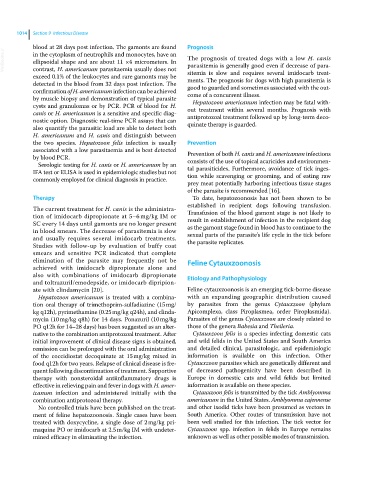Page 1076 - Clinical Small Animal Internal Medicine
P. 1076
1014 Section 9 Infectious Disease
blood at 28 days post infection. The gamonts are found Prognosis
VetBooks.ir in the cytoplasm of neutrophils and monocytes, have an The prognosis of treated dogs with a low H. canis
ellipsoidal shape and are about 11 ×4 micrometers. In
parasitemia is generally good even if decrease of para-
contrast, H. americanum parasitaemia usually does not
exceed 0.1% of the leukocytes and rare gamonts may be sitemia is slow and requires several imidocarb treat-
ments. The prognosis for dogs with high parasitemia is
detected in the blood from 32 days post infection. The good to guarded and sometimes associated with the out-
confirmation of H. americanum infection can be achieved come of a concurrent illness.
by muscle biopsy and demonstration of typical parasite Hepatozoon americanum infection may be fatal with-
cysts and granulomas or by PCR. PCR of blood for H. out treatment within several months. Prognosis with
canis or H. americanum is a sensitive and specific diag- antiprotozoal treatment followed up by long‐term deco-
nostic option. Diagnostic real‐time PCR assays that can quinate therapy is guarded.
also quantify the parasitic load are able to detect both
H. americanum and H. canis and distinguish between
the two species. Hepatozoon felis infection is usually Prevention
associated with a low parasitaemia and is best detected Prevention of both H. canis and H. americanum infections
by blood PCR. consists of the use of topical acaricides and environmen-
Serologic testing for H. canis or H. americanum by an
IFA test or ELISA is used in epidemiologic studies but not tal parasiticides. Furthermore, avoidance of tick inges-
tion while scavenging or grooming, and of eating raw
commonly employed for clinical diagnosis in practice.
prey meat potentially harboring infectious tissue stages
of the parasite is recommended [16].
Therapy To date, hepatozoonosis has not been shown to be
established in recipient dogs following transfusion.
The current treatment for H. canis is the administra- Transfusion of the blood gamont stage is not likely to
tion of imidocarb dipropionate at 5–6 mg/kg IM or result in establishment of infection in the recipient dog
SC every 14 days until gamonts are no longer present as the gamont stage found in blood has to continue to the
in blood smears. The decrease of parasitemia is slow sexual parts of the parasite’s life cycle in the tick before
and usually requires several imidocarb treatments. the parasite replicates.
Studies with follow‐up by evaluation of buffy coat
smears and sensitive PCR indicated that complete
elimination of the parasite may frequently not be Feline Cytauxzoonosis
achieved with imidocarb dipropionate alone and
also with combinations of imidocarb dipropionate Etiology and Pathophysiology
and toltrazuril/emodepside, or imidocarb dipripion-
ate with clindamycin [20]. Feline cytauxzoonosis is an emerging tick‐borne disease
Hepatozoon americanum is treated with a combina- with an expanding geographic distribution caused
tion oral therapy of trimethoprim‐sulfadiazine (15 mg/ by parasites from the genus Cytauxzoon (phylum
kg q12h), pyrimethamine (0.25 mg/kg q24h), and clinda- Apicomplexa, class Piroplasmea, order Piroplasmida).
mycin (10 mg/kg q8h) for 14 days. Ponazuril (10 mg/kg Parasites of the genus Cytauxzoon are closely related to
PO q12h for 14–28 days) has been suggested as an alter- those of the genera Babesia and Theileria.
native to the combination antiprotozoal treatment. After Cytauxzoon felis is a species infecting domestic cats
initial improvement of clinical disease signs is obtained, and wild felids in the United States and South America
remission can be prolonged with the oral administration and detailed clinical, parasitologic, and epidemiologic
of the coccidiostat decoquinate at 15 mg/kg mixed in information is available on this infection. Other
food q12h for two years. Relapse of clinical disease is fre- Cytauxzoon parasites which are genetically different and
quent following discontinuation of treatment. Supportive of decreased pathogenicity have been described in
therapy with nonsteroidal antiinflammatory drugs is Europe in domestic cats and wild felids but limited
effective in relieving pain and fever in dogs with H. amer- information is available on these species.
icanum infection and administered initially with the Cytauxzoon felis is transmitted by the tick Amblyomma
combination antiprotozoal therapy. americanum in the United States. Amblyomma cajennense
No controlled trials have been published on the treat- and other ixodid ticks have been presumed as vectors in
ment of feline hepatozoonosis. Single cases have been South America. Other routes of transmission have not
treated with doxycycline, a single dose of 2 mg/kg pri- been well studied for this infection. The tick vector for
maquine PO or imidocarb at 2.5 m/kg IM with undeter- Cytauxzoon spp. infection in felids in Europe remains
mined efficacy in eliminating the infection. unknown as well as other possible modes of transmission.

